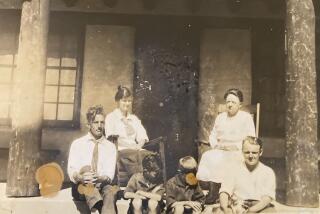Column: A new book tells the story of the Los Alamos National Laboratory -- one business card at a time
- Share via
What stories could a bunch of old Rolodexes possibly tell? A lot, it turns out — especially when those Rolodexes come from Los Alamos National Laboratory in New Mexico, where the scientists of the Manhattan Project built the first atomic bomb.
“Los Alamos Rolodex: Doing Business With the National Lab, 1967-1978,” an exhibit on display at the Center for Land Use Interpretation and a new book of the same name, gather various business cards from those Rolodexes and presents them, largely without comment, in a way that tells an interesting story about Los Alamos and the top secret work of the National Laboratory. Not to mention one about Atomic Age graphic design, full of flamboyant angles and boomerang shapes.
“What I like most about them is that they’re kind of a raw material,” says Matthew Coolidge, director at the CLUI, a 2-decades-old research and educational organization that looks at the ways in which humans interact with the landscape. “We feel that they’re rich enough that there might be many stories that might be extracted.”
The stories begin with how the CLUI came upon the Rolodexes to begin with. They came from the archive of the singular Ed Grothus, a machinist at Los Alamos who ultimately left the National Lab to become an anti-war activist. For decades, Grothus ran a tongue-in-cheek thrift store/museum in Los Alamos called “the Black Hole,” which sold old scientific equipment from the National Lab. The CLUI ended up with the Rolodexes after Grothus’ death, when the organization helped the family dispense of some of the material he’d accumulated over the years.
“In one of the boxes, which was in the yard, were a bunch of old Rolodexes,” says Coolidge. “They were stuffed with thousands of cards. And they were carefully dated on the back by whomever they belonged to.”
He says that one of the things that most impressed him about the collection was the geographic range of businesses covered — a spread that showed the extent of resources and talent from all over the U.S. that poured into Los Alamos.
“It shows this interaction, mostly from Albuquerque, where the Lab would go get everything from work gloves to structural building material supplies,” he explains. “But then you go farther afield, to Denver, for example, where a lot of the businesses are located. Denver is the closest large city to Los Alamos and is an important engineering center. And you have Los Angeles and Northern California with circuitry and semi-conductor firms. ... The San Fernando Valley and the South Bay are well represented.”
The cards show a close connection between Southern California and the National Lab and tell an interesting story about a time when the region was a vital aerospace hub. (For much of its life, in fact, the Lab was run by the University of California.) Some companies featured in the book are still in operation, such as Deltronic of Orange County. Though as is the case with so much manufacturing and engineering, others have moved to other states; Gardner Cryogenics of Glendale is now based in Pennsylvania. Yet others no longer exist.
There are also cards from businesses you don’t imagine would be working with a nuclear lab — such as Kodak.
“It reminds us that, in a way, atomic testing was a photographic event,” says Coolidge. “To understand how a bomb functions, you have to take high-speed pictures of a bomb as it explodes. Kodak had a big chemical division and it had all kinds of aerial photography equipment and mapping equipment and was involved in all kinds of documentation, so the photo process went deep into the atomic weapons program.”
And of course, there are the designs of the business cards — many of which often featured swooping Modernist images or head shots of the salesman in question, adding a personal touch to what can seem like an impersonal piece of Cold War history.
“The graphic design was something we appreciated in all of these cards,” says Coolidge. “It speaks to this period of great technological optimism. You see these images that look like car tail-fins from the ‘50s and ‘60s. They have a lot of rockets spinning into the apogee. Though, sometimes, you might see a cactus in the background to show that it was a Southwestern company.”
The book contains 150 business cards, but the CLUI is displaying 500 of them at its offices in Culver City. The staff there has been diligently researching the story behind each card: which companies might still be in existence, which phone numbers are still operational and the businesses that currently occupy the addresses listed.
“They are like the tips of icebergs,” says Coolidge of the business cards. “They were relics. They were dead-end in a way. They were so analog. Yet they are so real in terms of the personal connection that people had doing business with the National Lab. There was this human interaction and it was often rather poignant.”
“Los Alamos Rolodex: Doing Business With the National Lab, 1967-1978” ($17.95) was released this week by Blast Books. These cards and more are currently on view at CLUI’s Culver City location. There will be a slideshow and presentation about the Los Alamos Rolodexes Friday at 7 p.m. 9331 Venice Blvd., Culver City, clui.org.
Find me on Twitter @cmonstah.
More to Read
The biggest entertainment stories
Get our big stories about Hollywood, film, television, music, arts, culture and more right in your inbox as soon as they publish.
You may occasionally receive promotional content from the Los Angeles Times.











